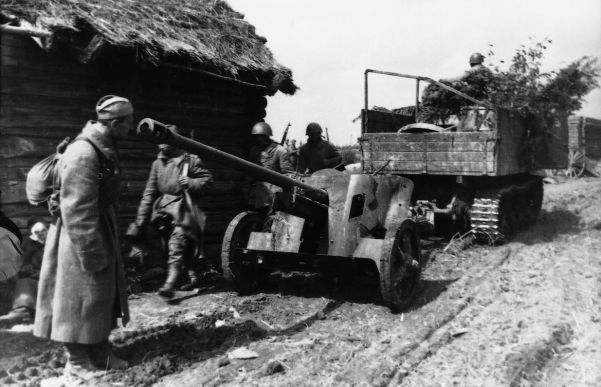
The need for an anti-tank gun with a calibre greater than that of the 3.7cm PaK 35/36 had been anticipated even as the PaK 35/36 was entering service, and the design of a new 5cm weapon began during 1938. The design authority was again Rheinmetall-Borsig, and the new weapon entered service late in 1940 as the 5cm Panzerabwehrkanone 38.
This was a capable gun that remained in service right to the end of World War II: firing tungsten-cored AP40 ammunition, the PaK 38 could successfully tackle all but the most heavily protected Allied tanks, and between 1941 and 1942 was the only German anti-tank gun able to penetrate the armour of the Soviet T-34 tank.
The employment of light alloys in the carriage lighted the equipment and made it easier to handle. The wheels had torsion-bar suspension that was locked when the trails were split, creating a stable firing platform.
Later in the war the PaK 38 was adapted for aircraft mounting as the Bordkanone 5 with an automatic feed system, and this was then used as the basis for the 5cm FlaK 214 anti-aircraft gun. As an anti-tank gun the PaK 38 was installed on a number of self-propelled mountings including the 5cm PaK 38 (Sf) auf leichter Selbstfahrlafette, the SdKfz 250 and the 5cm Pak 38 auf PzKpfw II nA.
Specifications
- Type
- medium towed AT gun
- Calibre
- 50mm (1.97in)
- Vehicle Length
- n/a
- Length of Barrel
- 3.173m (124.9in)
- Weight Travelling
- 986kg (2174lb)
- Weight in Action
- unknown
- Elevation Arc
- -8° to +27°
- Traverse Arc
- 65°
- Effective Ceiling
- n/a
- Road Range
- n/a
- Range
- 450m (490 yards)
- Projectile Weight
- 2.25kg (4lb 15.25oz)
- Armour
- n/a
- Engine
- n/a
- Muzzle Velocity
- 1198mps (3930fps)
- Speed
- n/a
